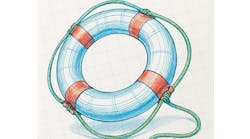Congratulations! You need to manage your own learning! Once you become a professional, you don't continue to learn by going to class to understand and memorize instructor-given facts and concepts. Further, the learning is no longer credentialed by test results on teacher-devised exercises.
To manage continued learning, you need to understand the learning process. Bloom’s Taxonomy is one categorization: mental activities associated with traditional learning (remember, understand and apply) are important intellectual activities, but they're among the lower levels of cognitive skills. By contrast, professionals also need to independently operate in the upper cognitive levels—analyze, evaluate and create.
Table I is a categorization of cognitive skills developed by a committee led by Benjamin Bloom and published in 1956. The table includes a description and examples. This categorization is regularly used in analyzing instructor-provided education.
| Level | Name | What the person does | Examples |
| 6 | Create | Create something new: purposefully integrate parts or concepts to design something new that meets a function | Design a device to meet all stakeholders' approvals within constraints. |
| 5 | Evaluate | Judge goodness, sufficiency and completeness of something, choose the best among options, know when to stop improving | Decide that a design, report, research project or event planning is finished, when considering all issues relevant to the context |
| 4 | Analyze | Two aspects related to context: 1) Separate into parts or stages, define and classify the mechanistic relationships of something within the whole 2) Critique, assess goodness, determine functionality of something within the whole |
1) Describe and model the sequence of cause-and-effect mechanisms |
| 3 | Apply | Independently apply skills to fulfill a purpose within a structured set of "givens" | Properly follow procedures to calculate a value, and use software features to properly present data |
| 2 | Understand | Understand the relation of facts and connection of abstract to concrete | Find the diameter of a 1" dia. pipe, convert units, qualitatively describe staged equilibrium separation phenomena |
| 1 | Remember | Memorize facts and categorization | Spell words, recite equations, name parts of a valve, read resistance from color code, recite the Bloom's six levels |
Table 1: Mental activities associated with traditional learning (remembering, understanding and applying) are important intellectual activities, but they're the lower levels of cognitive skills. By contrast, professionals also need to independently operate in the upper cognitive levels—analyzing, evaluating and creating.
Unfortunately, classroom education tends to keep students operating in the three lower cognitive levels—follow the instructor, memorize and understand, then demonstrate by application on simplistic problems or lab exercises. The instructor prescribes the topics and method of learning, and student proficiency is evaluated by the instructor. When such education is perceived by the student as professional preparation, this conventional learning environment misdirects the students’ perspectives about what it means to be a professional partner in the enterprise. The job of a practitioner is not to learn, but to do. Not to follow, but to lead.
Learning is valued when it is necessary to support doing, but the schooldays view of “learning for learning’s sake” is viewed as a diversion. Further, in independent learning, the topics are chosen by the student, proficiency is evaluated by the student, and neither are done by the instructor.
Learning to learn
To shift the perspective away from the classroom environment, and prepare students for lifelong, independent learning, here is a categorization of methods of learning:
Stage 1—This is instructor-led learning, with generic testing on trivial questions. There is a benefit to instructor-led learning. Novices don’t know what they need to know, and they benefit from direction, close learning supervision, and detailed guidance about every step and concept.
However, there are several unfortunate aspects of the Stage 1 method. Its idealization misdirects the learner’s view of the reality of applications. Further, because school environments keep students at lower cognitive levels, by graduation, the system has progressively selected those fittest for this be-a-follower environment and lower-level cognitive activity.
Once one has gained experience, self-directed learning is more efficient because it focuses on the learner’s need of the topics and on acquiring an adequate level of skill to meet the need. Instructor-directed learning isn't bad, but it's guided by someone else’s perception of the appropriate topics, so, it diverts the learner’s focus and attention away from their specific needs.
Stage 2—At this intermediate learning stage, the learner has the fundamental basis, and only needs a brief an overview of the procedure. The learner has the knowledge to fill in the gaps. A brief training session to see if the learner can apply the procedure is all that's needed to be observed by the trainer. As an analogy, initial driver’s education to the beginner is an extensive, multi-session, multi-concept, instructor-led training. That would be Stage 1. But, by the time you've bought your third car, all you need from the salesperson is a brief overview of how to operate it. This is Stage 2. Certifications, in-house training, corporate universities, and short courses could all be classified as Stage 2 methods.
Stage 3—At this stage, the self-learner learns in isolation, perhaps from books, monographs, webinars, professional magazine articles, whitepapers or product bulletins. The learner, then self-tests for competence, and applies the methodology to offer a solution. Perhaps the boss asks other resident experts if the answer seems right. Mostly it is right, but nuance or context may be missing, or a small issue erroneously or incompletely learned. And feedback from expert review will help the learner make appropriate learning and self-evaluation corrections.
The self-learner progressively learns how to self-validate that the application is properly done and that the result is right within the context.
Stage 4—Finally, the individual can create new procedures, grounded in fundamentals, meeting multiple objectives or an application context, and can defend the validity of the knowledge. Rather than learning what others have discovered, they create knowledge. We seek to raise graduate students to Stage 4, then reward them with a PhD when they get there. Industry also coaches employees toward this level of learning proficiency, and rewards them with senior technical positions when they get there. The titles don't mean that they know everything, but show they know how to analyze and evaluate to achieve the right method or conclusion.
Table II summarizes these four stages.
| Stage | Name | Description |
| 1 | Novice | Typical classroom where novices follow the instructor-led progression, and memorize and understand when they're told |
| 2 | Training | Learner has the fundamentals to understand, but relies on instructor to be the guide and certifier of competency |
| 3 | Self-learn | Independently read or watch, come to understand and be able to apply, self-test and decide when competent, final validation is by other experts |
| 4 | Create new | Independently create new procedures, descriptions, equations, which are grounded in valid principles, and validated by comprehensive tests |
Table 2: The four stages of learning progress from traditional, classroom-based information transfer to the active creation of new knowledge.
Graduating from Stage 1
A question is, how far along this progression of learning stages can colleges take engineering undergraduates? I don’t think very far.
Notably, knowledge leads the professor’s attention. That focus is about the science and fundamentals, and usually in an isolated context to permit defensible claims. This contrasts the application within complexity of engineering practice. The academic values of discovery and possibility aren't those of the industrial environment of constrained application. Further, there are many new topics and fundamentals that students need to learn, and school necessarily needs safe and low-effort approaches for grading. Consequently, it's expedient to keep students at the lower cognitive levels.
Furthermore, 17- to 20-year-olds have a much different life experience, perspective, professionalism and maturity than 40-year-olds. We shouldn't expect the undergraduate student, a novice in many aspects, to be able to work at the independent Stage 4 level. If they did, we wouldn't need teachers to plan the courses or validate student proficiency.
Neither can we expect colleges to be able to provide education far away from Stage 1.
What about credentialing organizations that offer continuing education classes and training courses? This is also important, but this is Stage 2.
The post-classroom stages of professional learning are more aligned with a master-apprentice relationship, and the coaching would be from the practice-grounded, context-grounded supervisor. A schoolroom experience is fully capable of Stage 1 learning, and training courses for Stage 2 learning, but neither for lifelong learning.
The message
The acquisition of advanced degrees and certifications is evidence of continued learning, which is good and useful. However, it keeps you in learning Stages 1 and 2, where you're dependent on others to shape your personal growth. You need to take charge of your progress.
School kept you at Stage 1 for about 18 years. You succeeded, and the comfort of returning “home” can be a strong pull. Stage 1 and 2 methods can be of value and appealing, while collecting credentials may be image-boosting. But work to rise into Stage 3 and then Stage 4.
In our community, technical topics usually dominate the concepts of learning. At least as important to engineering effectiveness are the soft skills (communication, interpersonal, political, etc.). Seek to grow in all areas.
Use the Stage 1-4 model to monitor your learning and Bloom’s Taxonomy to monitor your level of cognitive activity. As you're doing things (at work, home or play) observe what stage or level you're at. All are important. Just don’t stay at the lower stages and levels. And, coach your employees to move to Stage 3, too.
Several years ago, I wrote a Control article, "How to be your own professor," listing about 20 things to do to become your own teacher. Use those suggestions as a DIY guide to develop your own potential.






